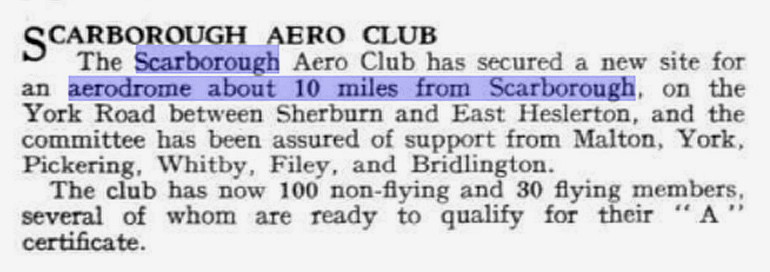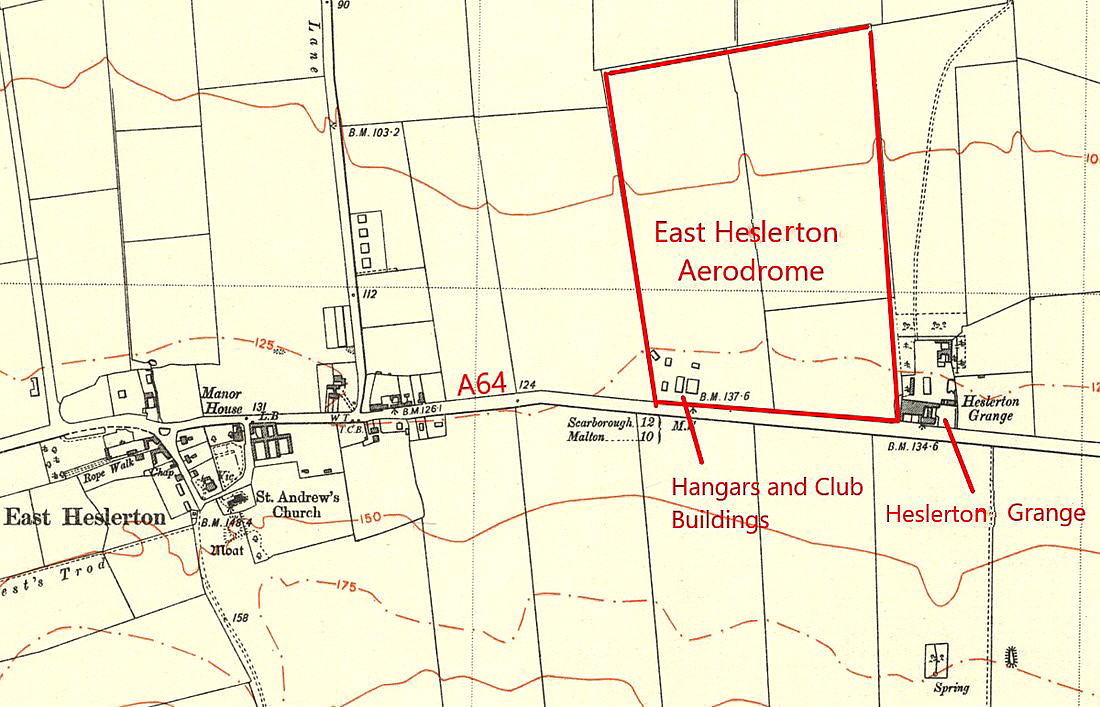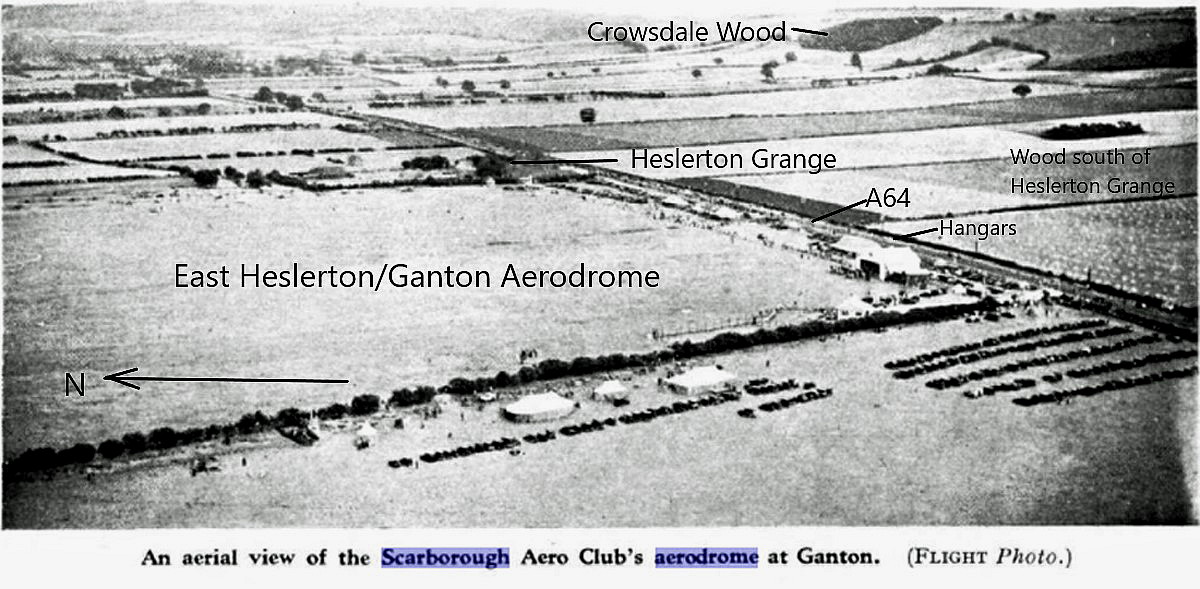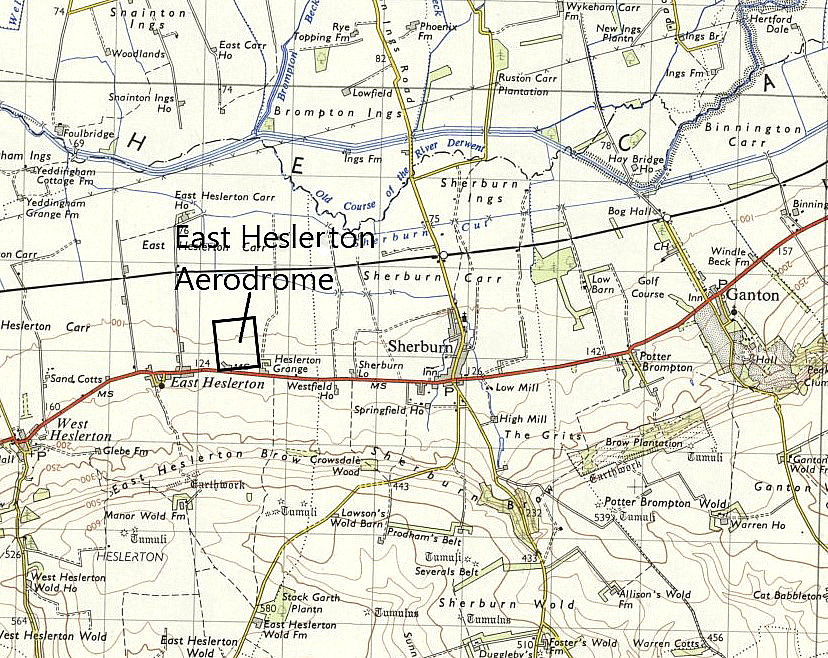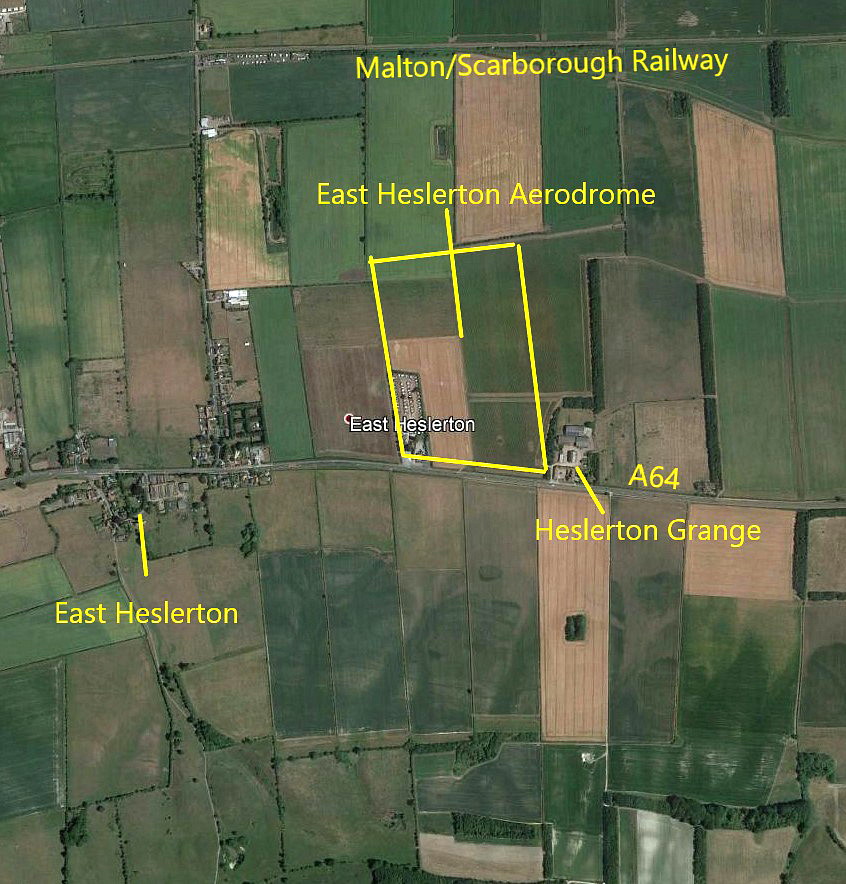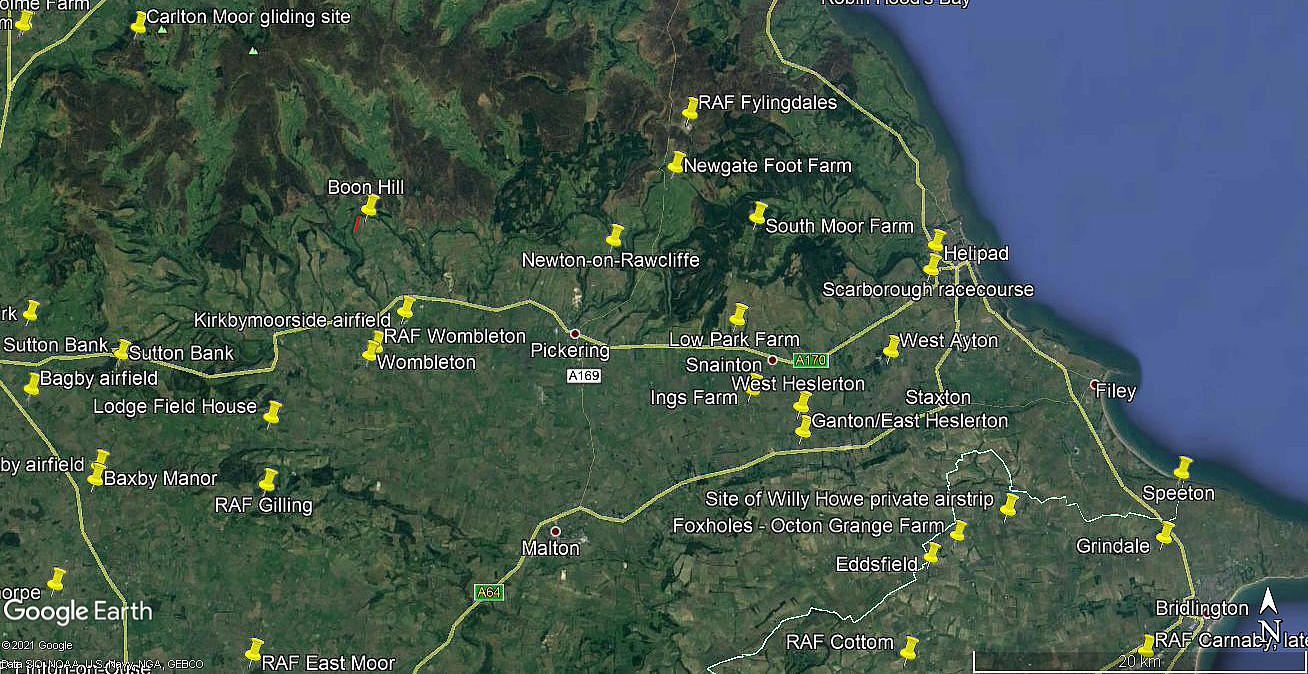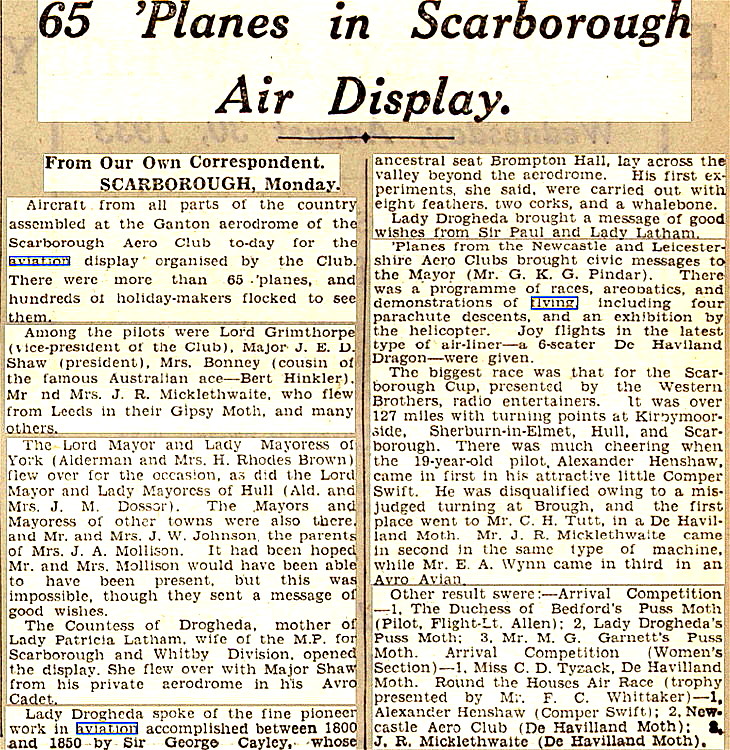Ganton
GANTON AERODROME: Civil aerodrome
Notes: It is all rather confusing as this site is also known as EAST HESLERTON in equal measure. But, as this was also the location of an WW1 aerodrome, I shall retain the two names to seperate the two eras of operation. See the listing for EAST HESLERTON for some of the WW1 history.
A MICHAEL T HOLDER GALLERY
Note: The first item was published in Flight magazine on the 4th March 1932: The third item, an aerial picture, was published in Flight magazine on the 28th September 1932. The fourth item, an article from Flight magazine, was published over a month earlier, on the 13th August 1929.
Note: The first and third pictures were obtained by Mike Holder from Google Earth ©, and I added the fourth picture from my own Google Earth © database.
Operated by: The Scarborough Aero Club
Location: W of Ganton village on the A64, roughly 7nm SSW of Scarborough.
Period of operation: 1930s only?
NOTES:
In late 2013 I discovered a press report on the web concerning “Scarborough Club’s Third Air Display” which was held on the 7th August 1933, and much of this seems well worth repeating for this 'Guide' as it gives us such a graphic description of similar events held in those days.
“Twelve months ago, the Scarborough Aero Club celebrated its transference to the aerodrome at Ganton by organising a flying display. These last twelve months have been full of vicissitudes for the club, but despite this, much obvious progress has been made. The members are really keen pilots, and a very high number of hours per member is consistently recorded.” (My note: Where was the Scarborough Aero Club based before 1932? Possibly at OLIVER’S MOUNT?)
A GREAT ASSET
“It is a great asset to a town like Scarborough to have a really lively aero club, as was pointed out by the Mayor (Councillor G.K. Pindar) in the programme, where he expressed the hope that the display might not only prove an attraction to the spectators, but also a means of drawing attention of the rapidly growing number of private owners, and others interested in civil aviation, to the excellent facilities provided by the club at Ganton Aerodrome. It is difficult to understand why every seaside town, which, like Scarborough, is so dependent upon its visitors, does not have an aerodrome with comfortable facilities to attract air visitors. The secretary and all the club members there are always ready to go out of their way to help anyone who visits them, and their example is one to be followed.”
The above is interesting on at least two counts. The first being that this was clearly propaganda to try and entice the rich and famous to visit Scarborough. (See below). The second being that private pilots might well wish, along similar lines today (eighty years later) for an aerodrome convenient to visit such resorts. By and large this still hasn’t happened; quite understandable given the convenience of using a car, much improved roads, etc, etc. The very wealthy people today also have other travel aspirations needless to say.
A BANK HOLIDAY
“Monday, August 7, was Bank Holiday, so they hoped to attract large numbers of the general holiday public to Ganton. Unfortunately, they only got some 2,000 or 3,000, few of whom can have been the type likely to be of ultimate value to the club. There must have been something lacking….” There was something lacking, and this was because because this event was not designed to be a public air display, but rather an excuse for the privileged class to meet up and have a day out.
For example, “An Arrival competition was the first item; this was won by Flt. Lt. J. B. Allen, pilot to the Duchess of Bedford, who came in the “Puss Moth” in which he flies Her Grace about such a lot. Second was F/O H.C.D. Hayter, who brought Kathleen Countess of Drogheda up in his “Puss Moth”. Third was Mr. Garnett, a Yorkshire Aeroplane Club member, who flew a “Moth” from Yeadon.” I expect you’ll have got the drift.
THE DIGNITARYS
“Besides the Mayor and Mayoress of Scarborough, there were the Lord Mayors and Lady Mayoresses from both York and Hull, who incidentally came by air. Lady Drogheda opened the meeting, and in doing so drew attention to the fact that Sir George Cayley’s house was visible from the aerodrome. She thought that as Sir George was justifiably called the “Father of Aviation,” it would be only fitting if some memorial were erected to him.”
I find this very interesting; obviously Lady Drogheda was very well informed. It took me quite a bit of time researching British aviation history around the turn of the 21st century before I became fully aware of the immense importance of Sir George Cayley in establishing the basic rules of aircraft design. Some say he invented the science of aerodynamics but surely this is ‘over-egging’ the history somewhat? Especially as a small handful of people had constructed pretty successful 'hang-glider' designs in around the 10th and 11th centuries. See MALMESBURY for example.
AERO CLUB ARRIVALS
“Three aircraft arrived in formation from the Leicestershire Aero Club, and also from the Newcastle Aero Club. In both cases they brought letters from the Mayors of their respective cities, which were handed over with due ceremony to the Mayor of Scarborough.” This clearly indicates that rather than being an Air Display for the public, the event was really more of a ‘Garden Party’ for civic dignitaries and aristocracy.
MRS BONNEY ARRIVES
Another visitor who arrived and “caused a great deal of interest” was Mrs Bonney who, “…had recently flown from Australia in a “Moth.” (I believe this was a Gipsy 1). Until late 2013 I had never heard of Maude Rose “Lores” Bonney (1897 – 1994) who, in the 1930s was a much acclaimed Australian aviatrix having flown a Gipsy Moth (presumably VH-UPV?) around Australia in August and September 1932; a most demanding task which was arguably far more difficult to achieve than Amy Johnson faced flying to Australia in 1930. Not that I am decrying Amy's magnificent achievement.
It appears that after Mrs Bonney landed at CROYDON in her de Havilland DH60G Gipsy Moth VH-UPV, on the 21st June 1933, she was awarded the OBE, (some say MBE), for her courage and perseverance. She had departed from Archerfield, Brisbane on either the 10th or 15th April 1933 and became the first woman to fly from Australia to England. As she wasn’t interested in setting records and lacked a ‘PR’ backing her name quickly faded. However, having returned to Australia she purchased the Klemm KL32V VH-UVE in 1935. This was originally registered D-2299 when first registered in Germany and was imported to the UK, (perhaps after visiting Africa/Kenya as D-2299) as G-ACYU which; after being brought by Normand Berry Littlejohn of Melbourne, he then flew from England to Australia.
Departing on the 13th April 1937 she arrived in Cape Town four months later. I now find this aspect of aviation fascinating. I would have thought, before researching this ‘Guide’, that a general list of remarkable aviation achievements would be readily available. But not so it seems, and therefore so many quite astonishing achievements in aviation history seem to get virtually lost. This said, for example, who could have foreseen that my awareness of Mrs Bonney could have been accessed via a simple listing of GANTON aerodrome - resulting in a bit of research regarding this site.
FLY-PASTS & AIR RACES
“A representative fly-past took place, comprising some 19 aircraft of fourteen different types. They were chosen from among the fifty odd visiting aircraft. Mr. R.A.C. Brie, after flying the “Autogiro” round, landed in front of the main enclosure with the engine stopped.” Presumably a Cierva type? “There were two races during the afternoon. The first designated “Round the Ridings,” was over a course of about 127 miles, covering most of Yorkshire, and the second, called “Round the Houses,” being three laps of a 12-mile course so arranged that the aeroplanes were in view for most of the time. They each attracted a number of entries, and our tables give a good idea of how excellent the handicapping of Messrs. Dancy and Rowarth was. The finish of the second race was one of the best we have ever seen, and certainly came nearer to raising a modicum of interest among the general public, than most races do.”
Isn’t that last comment so very interesting? As this period was the hey-day of air racing I suppose we tend to assume that these events attracted a great deal of public interest, but this may not have been the case at all; the public perhaps sitting these races out, between aerobatic displays and similar more immediate attractions? “There was an orgy of parachute jumping. Mr. Fairlie (G.Q.) and Messrs. George de Greeuw, and Marsland (all Russell-Lobes) vied with one another in attempting to land in the aerodrome circle after jumping out from about 1,500 ft. The first named was the victor.” The Russell ‘Lobe’ parachute was first introduced in 1929, and modified versions were regularly introduced thereafter.
A "CONTOURS d'ELEGANCE"
The account continued by quaintly saying “A Contours d’Elegance” was held. “….won by Flt. Lt. Allen with the Duchess of Bedford’s “Puss Moth”. This machine will soon have won a prize for this event at nearly every flying meeting in the country, if it continues at the present rate; it is really beautifully kept, and Flt. Lt. Allen ought to be congratulated on the condition of the engine in particular. Mr. Henshaw was second with his Comper “Swift”. A second class in this competition, provided for machines with a history. The first prize went to Mrs. Bonney, whose “Moth” has carried her from Australia, and the second prize to Mr. Richardson, whose “Blue-bird” had been flown to the Cape during February, 1929, by Wing Com, (then Sqd. Ldr) L.H. Slatter.”
AN INTERESTING ASPECT?
I find it interesting that a relatively minor aerodrome such as this attracted many dignitaries and some really significant pilots of that era. The author of the article was not so impressed saying; “Other similar events, mostly repetitions, carried the programme to 9.30 p.m. It was really very bad luck on the club not getting better support for this meeting, and this seems the right time to review the whole question of the type of display which clubs should organise.”
On a more upbeat note he then adds; “Mr H. Bailey brought down one of the Blackburn “B.2” Trainers from the Reserve Training School at Brough, and put up a very pretty show. His machine was fitted for inverted flying, an asset of which he made the best possible use.” As an aside I moved the sole remaining airworthy Blackburn B.2 G-AEBJ from BROUGH to Sandy, Bedfordshire in my truck in February 2007 for restoration. I was told this was the last airworthy aircraft to leave BROUGH before the airfield closed.
A COMMON ENOUGH COMPLAINT FOR MANY A YEAR
“Mr. S. A. Thorn is one of the best-known pilots for doing something really spectacular, and is well worth watching. On an Avro “Cadet” he maintained his reputation. The loudspeaker arrangements were by no means adequate for the enclosures, which was a pity, as shows like Thorn’s and Bailey’s are greatly enhanced and their interest increased when a running commentary is given about them. The general public do not appreciate the finer points of the flying, especially manoeuvres like the “bunt”, which Thorn appeared to do easily, unless they are told all about them while they are being performed.”
I hope you will agree that the following is also of interest, especially given the usually superb facilities and management of flying displays we have enjoyed for many years. On the other hand would a reporter today on a local paper be provided with the space to make such an in depth critique? I very much doubt it.
“Circumstances are not always the same, and therefore the type of publicity and programme which is suitable for a municipal affair near a large city may not be the most suitable for a young and growing club, whose aerodrome is some distance away from the town, and who wants to attract, not the general public, but potential members. If we are to judge by the comments of those in the club enclosure, and also those in the “bob” enclosure, the display at Ganton fell short of the ideal on many counts, the result being by no means commensurate with the amount of work put in. The club itself was not, in this case, responsible for the programme, but only for the ground organisation. This certainly went smoothly, and all visitors were made most welcome, although it looked as if Mr. Baynes and his fiancée, Mr. Bower and Wing. Com. Woodhouse could all have done with a little more help than they got.”
Damned with faint praise seems appropriate?
“As regards the programme, we feel that a snappier one, with something in the air the whole time, no waits and more real flying, would have filled the bill better. It ought not to have been longer than from 3 to 5.30 p.m., so that there would have been more time for joy-riding and consequent financial reward. As it was, it was only possible to carry out intermittent joy-riding, and large numbers of people had to be turned away. It ought to have been possible to arrange that the heats for the second race were run off during the morning, and that there was something doing in the air right up to the moment that those in the finals were ready to start.
Races like that are not very exciting and, judging from the remarks we heard in the cheap enclosure, did not interest the general public at all. The final of the short race was good, and proved again the expertness of our handicappers, but even that appeared to only excite those directly concerned with the competitors.”
This commentator certainly appears to have got his finger on the pulse.
“No, it ought to be realised that a club like Scarborough benefits far more by going out to get only those who are keen on club flying. It doesn’t cost a very great deal to invite all that sort of people, circularising other clubs will do a lot, and the result will be that the gathering is composed of people who are definitely interested in the club as a club, and for what it can offer them either as members or as air visitors. The flying programme need then also cost but little and be merely an excuse for a garden party.
Where the general public are got to the aerodrome by expensive press and other advertising, it is vitally necessary that they are given a programme which will make them feel that they have got value for their money. They are not interested in the club itself; all they want are thrills out this “this ‘ere aviation business,” and if they don’t get them, but have to sit about during long waits, they just go away fed up and bored stiff with flying, a result which does no good to those whose livelihood depends on getting new people into the game; in fact, it definitely makes things more difficult.”
I THINK HE GOT IT RIGHT
Written in 1933 this commentator predicted and described exactly how things would eventually work out. Public air displays today are invariably filled with constant interest, timed minute perfect in many cases. Whereas “Fly-Ins” for pilots with the possibility of a small amount of “display flying” included along the way in some cases, are generally reserved for those 'hard-core' aviation enthusiasts. This said, the organisers of the Bournemouth Air Display in 2014, attended over three days by hundreds of thousands of spectators, could well have taken notice of this 1930s critique.
Later, Mike Holder, a great friend of this 'Guide' discovered this article, published in the Leeds Mercury on the 8th August 1933.
ANOTHER NOTE TO ADD
In January 2024 Mr Graham Frost, another great friend of this 'Guide', discovered that the de Havilland DH60X Moth, G-AAMV, had been registered to the Ganton Flying Club from 03.06.39 until 10.09.40, when it was impressed as BK844. But, I noted, the address, even this late on, was: The Aerodrome, East Heslerton.
A bit later Graham found that the de Havilland DH60G Moth, G-AAZE, had also been acquired by the Ganton Flying Club, and was registered to the same address from 12.06.39 until 10.09.40, this being impressed as BK843.
We'd love to hear from you, so please scroll down to leave a comment!
Leave a comment ...
Copyright (c) UK Airfield Guide















